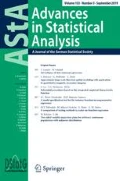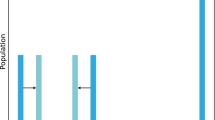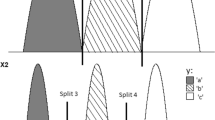Abstract
In this paper we develop a measure of polarization for discrete distributions of non-negative grouped data. The measure takes into account the relative sizes and homogeneities of individual groups as well as the heterogeneities between all pairs of groups. It is based on the assumption that the total polarization within the distribution can be understood as a function of the polarizations between all pairs of groups.
The measure allows information on existing groups within a population to be used directly to determine the degree of polarization. Thus the impact of various classifications on the degree of polarization can be analysed.
The treatment of the distribution’s total polarization as a function of pairwise polarizations allows statements concerning the effect of an individual pair or an individual group on the total polarization.
Similar content being viewed by others
References
D’Ambrosio, C. (2001) Household characteristics and the distribution of income in Italy: an application of social distance measures. The Review of Income and Wealth 47(1), 43–64
Duclos, J.-Y., Esteban, J., Ray, D. (2004) Polarization: Concepts, measurement, estimation. Econometrica 72(6), 1737–1772
Esteban, J., Gradín, C., Ray, D. (1999) Extensions of a measure of Polarization with an Application to the income distribution of five OECD countries. Working Paper No. 218, Maxwell School of Citizenship and Public Affairs, Syracuse University, Syracuse, New York
Esteban, J., Ray, D. (1994) On the measurement of polarization. Econometrica 62(4), 819–851
Esteban, J., Ray, D. (1999) Conflict and distribution. Journal of Economic Theory 87, 379–415
Gradín, C. (2000) Polarization by sub-populations in Spain, 1973–91. The Review of Income and Wealth 46(4), 457–474
Mosler, K., Schmid, F. (2005) Beschreibende Statistik und Wirtschaftsstatistik. Springer, Berlin
Schmidt, A. (2004) Statistische Messung der Einkommenspolarisation. Eul Verlag, Lohmar-Köln
Wang, Y.-Q., Tsui, K.-Y. (2000) Polarization orderings and new classes of polarization indices. Journal of Public Economic Theory 2(3), 349–363
Wolfson, M.C. (1994) When inequalities diverge. The American Economic Review 84(2), 353–358
Zhang, X., Kanbur, R. (2001) What difference do polarisation measures make? An application to China. Journal of Development Studies 37, 85–98
Author information
Authors and Affiliations
Corresponding authors
Rights and permissions
About this article
Cite this article
Bomsdorf, E., Otto, C. A new approach to the measurement of polarization for grouped data . AStA 91, 181–196 (2007). https://doi.org/10.1007/s10182-007-0027-0
Received:
Revised:
Published:
Issue Date:
DOI: https://doi.org/10.1007/s10182-007-0027-0




